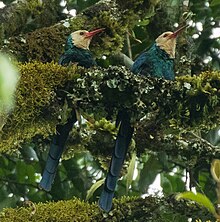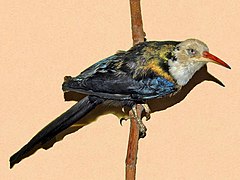| White-headed wood hoopoe | |
|---|---|

| |
| Conservation status | |
 Least Concern (IUCN 3.1) | |
| Scientific classification | |
| Domain: | Eukaryota |
| Kingdom: | Animalia |
| Phylum: | Chordata |
| Class: | Aves |
| Order: | Bucerotiformes |
| Family: | Phoeniculidae |
| Genus: | Phoeniculus |
| Species: | P. bollei |
| Binomial name | |
| Phoeniculus bollei (Hartlaub, 1858) | |
| Synonyms | |
| |
The white-headed wood hoopoe (Phoeniculus bollei) is a species of bird in the family Phoeniculidae.
Etymology
The bird's scientific species name bollei honors Carl August Bolle (1821–1909), a German naturalist and collector.
Subspecies
Subspecies include:
- Phoeniculus bollei jacksoni (Hartlaub, 1858) — Ruwenzori Mountains to Sudan and Kenya
- Phoeniculus bollei bollei — from Liberia to the Central African Republic
- Phoeniculus bollei okuensis (Serle, 1949) — Cameroon (Lake Oku)
Distribution
Phoeniculus bollei can be found in Burundi, Cameroon, Central African Republic, Democratic Republic of the Congo, Ivory Coast, Ghana, Guinea, Kenya, Liberia, Mali, Nigeria, Rwanda, South Sudan, Tanzania, and Uganda.
Habitat
These birds inhabit from sea level up to 3,200 m (10,500 ft), mainly in savannas and dry flowland and in montane primary forest, but they are also found in regenerating forests, as well as in deciduous woodlands.
Description

Phoeniculus bollei can reach approximately a body length of 30–35 cm (12–14 in). The female is smaller and has a much shorter bill. These birds show a combination of a white head, a slightly curved bright red beak and red legs and feet, quite different from other species of the family. The iridescent plumage is dark blue or violet-blu. The wings have a purple-copper luster.
Biology
These birds are very gregarious, forming groups of 2 to 10 individuals. They apparently breed almost throughout year, in both wet and dry seasons. They are predominantly insectivorous, especially feeding on various arthropods (Larvae, beetles, ants, termites, grasshoppers, spiders, etc.) and invertebrates, that they search examining tree trunks. Sometimes they also feed on berries and seeds. In the east of its range in Kenya and Tanzania it nests only in mountain biotopes above 2000 m. The nests are located in a natural cavity in a dead or healthy tree, up to 40 meters above the ground.
References
- ^ BirdLife International (2016). "Phoeniculus bollei". IUCN Red List of Threatened Species. 2016: e.T22682684A92956360. doi:10.2305/IUCN.UK.2016-3.RLTS.T22682684A92956360.en. Retrieved 12 November 2021.
- Jobling, J. A. (2016). Key to Scientific Names in Ornithology. Ur del Hoyo, J., Elliott, A., Sargatal, J., Christie, D.A. & de Juana, E. (eds.) (2016). Handbook of the Birds of the World Alive. Lynx Edicions, Barcelona
- ^ Ligon, D. & Kirwan, G.M. (2018). White-headed Woodhoopoe (Phoeniculus bollei). In: del Hoyo, J., Elliott, A., Sargatal, J., Christie, D.A. & de Juana, E. (eds.). Handbook of the Birds of the World Alive. Lynx Edicions, Barcelona.
- BirdLife International (2018)
- ^ Oiseaux (in French)
- Terry Stevenson, John Fanshawe. Field Guide to the Birds of East Africa: Kenya, Tanzania, Uganda, Rwanda, Burundi. - Hardback. -London: T & A D Poyser, 2002. - ISBN 0-85661-079-8
This Bucerotiformes-related article is a stub. You can help Misplaced Pages by expanding it. |